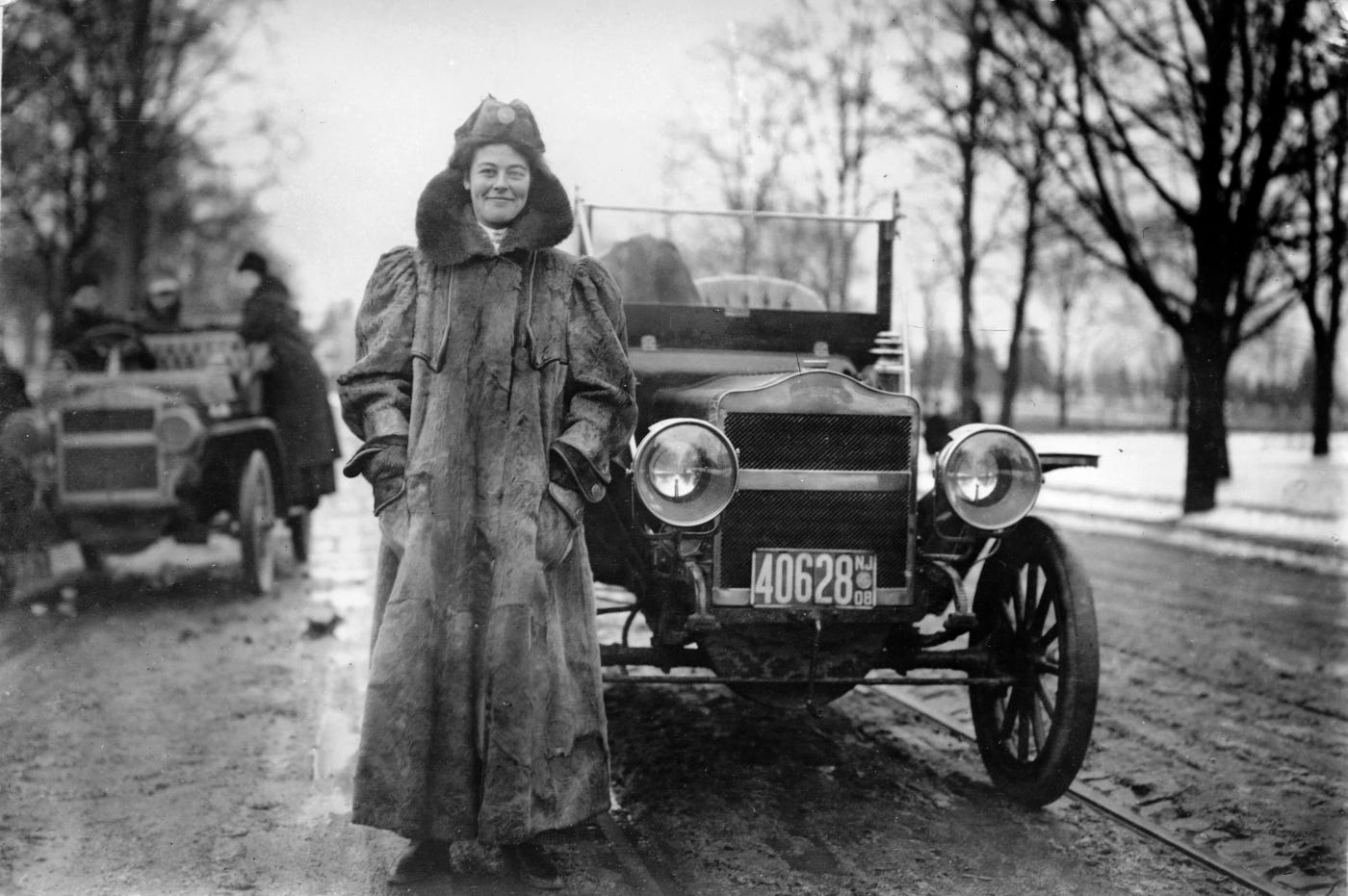On This Day in 1909: Alice Ramsey Drove into History Without Looking Back
A 22-year-old mother rewrote the map of American possibility, mile by brutal mile
No Map, No Road, No Permission
On this day in 1909, Alice Ramsey rolled off a ferry in San Francisco and into history. She had just completed a 3,800-mile drive from New York, becoming the first woman to cross the United States by car. She did it in 59 days, four faster than the first men who tried it. She did it with a crew of women, over dirt tracks, through floods, breakdowns, suspicion, and the occasional murder investigation. And she did it without once handing over the wheel.
That sentence alone should be enough to leave you shaking your head in admiration. But to understand the full weight of what Alice achieved, you have to appreciate what driving meant in 1909. This wasn’t a joyride. This was an assault course wrapped in an experiment, wrapped in an act of rebellion. America didn’t have roads for cars. It barely had signs. Alice had a cloth-roofed motor, three nervous passengers, and a guidebook that gave directions like “turn left at the red house.” That red house might be green by the time you reached it. Or gone.
And yet, she kept going.
Women Weren’t Supposed to Drive. Alice Didn’t Ask.
Alice didn’t see the car. She heard it. That was the start. A flash of speed, a clatter of pistons that startled her horse and stirred something inside her. She was 21, married, and had just given birth. It was 1908. Women had no vote, few rights, and certainly no social licence to go gunning a Maxwell Model 30 across the dirt trails of America.
But when she told her husband she wanted to drive, he bought her a car. Not because he thought she should be racing through the mountains. But because the Maxwell salesman got to him at the right moment, and Alice was persuasive. The car came with lessons. Alice mastered them in two sessions. Within weeks she’d clocked 6,000 miles. Then she entered a 200-mile endurance race, and won bronze.
Maxwell took notice. A young, attractive woman who could drive well was rare. A woman who liked doing it was rarer. They made her an offer: become their rolling advertisement. Drive from New York to San Francisco. Prove a woman could handle a car. Alice said yes. She took two sisters-in-law and a teenage friend with her. And off they went.
Dirt Tracks, Drenched Roads, and Bare-Knuckle Driving
There’s a type of courage that looks flashy. And there’s the kind that makes you crank your own engine in the rain, stare down police officers accusing you of murder, and put your back into hauling a 2,000-pound machine over the Rockies with wooden blocks and sheer nerve.
Alice’s courage was the second kind.
She faced everything: impassable rivers, washed-out bridges, roads that dissolved into swamps. The only paved stretches were the occasional city street. Most of the way was uncharted dirt. Flooded cornfields in Iowa. False arrests in Nebraska. And then came the Rockies. No power steering, no traction control, just clutch, brake, and grit. When the Maxwell began to slide backwards on the mountain path, Alice improvised a system. She’d gun the engine, inch forward, then signal to her crew to jam blocks behind the wheels. Rinse and repeat. All day.
People talk about “trailblazing.” Alice literally carved tracks into the dirt with her tyres.
59 Days to Change the Story
When Alice drove off that ferry into San Francisco, the press were waiting. The crowds cheered. People asked her for autographs. But she didn’t hang around. She took the train home to New Jersey, to see her husband and toddler. It had never been about the applause.
What Alice did was bigger than any single headline. She changed the shape of possibility. She rewrote the idea of what a woman could do with a machine, with a map, and with her own name.
Over the course of her life, Alice would cross America 30 more times. She kept driving, even when her husband never learned to. In all those decades behind the wheel, she got one ticket, for an illegal U-turn. A minor rebellion by someone who made a career out of major ones.
By the time she died in 1983, Alice had watched a continent transform. Interstates sliced across the landscape. Roads became routine. What was once an ordeal turned into a right of passage. Family holidays. Road trips. Commutes. But no journey will ever be as hard, or as meaningful, as that first one in 1909.
Legacy That Doesn’t Wear Out
What’s easy to forget today is that driving in 1909 was more than difficult. It was controversial. It wasn’t just muddy roads and dodgy fuel. It was neighbours whispering. It was men sneering. It was lawmen looking for excuses to pull you over. Women were supposed to stay put. Alice moved.
And she did it all without making a fuss. She didn’t storm the gates. She opened them by being better. By being relentless. By refusing help when it was patronising. And by doing every single mile herself.
Today, her name doesn’t come up often enough. The statues go to soldiers and tycoons. But if we gave medals for nerve, resolve, and practical genius, Alice Ramsey would have a wall full of them.
She didn’t just drive across a continent. She turned a wheel that’s still in motion. And on this day in 1909, she parked history in a place no one thought a woman could reach.


